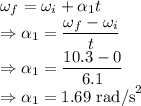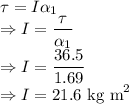
Physics, 09.04.2021 02:10 soccergirly7588
A torque of 36.5 N · m is applied to an initially motionless wheel which rotates around a fixed axis. This torque is the result of a directed force combined with a friction force. As a result of the applied torque the angular speed of the wheel increases from 0 to 10.3 rad/s. After 6.10 s the directed force is removed, and the wheel comes to rest 60.6 s later.
(a) What is the wheel's moment of inertia (in kg m2)? kg m
(b) What is the magnitude of the torque caused by friction (in N m)? N m
(c) From the time the directed force is initially applied, how many revolutions does the wheel go through?
revolutions

Answers: 2


Another question on Physics

Physics, 21.06.2019 17:00
If you touch a hot light bulb and get burned, that is an example of a. radiation b. convection c. conduction
Answers: 1

Physics, 22.06.2019 04:50
Find v(t), given acceleration a(t)=7j and initial velocity v(0)=k
Answers: 2

Physics, 22.06.2019 11:30
If we relied solely on the nonrenewable resources found in the u.s., which one would we run out of first at current usage levels? a. natural gas b. oil c. uranium d. coal
Answers: 1

You know the right answer?
A torque of 36.5 N · m is applied to an initially motionless wheel which rotates around a fixed axis...
Questions





English, 08.02.2021 21:30



Physics, 08.02.2021 21:30

SAT, 08.02.2021 21:30




Arts, 08.02.2021 21:30



Social Studies, 08.02.2021 21:30


Physics, 08.02.2021 21:30





 = Torque = 36.5 Nm
= Torque = 36.5 Nm = Initial angular velocity = 0
= Initial angular velocity = 0 = Final angular velocity = 10.3 rad/s
= Final angular velocity = 10.3 rad/s









